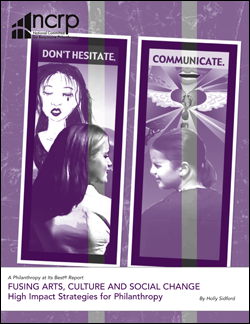Fusing Arts, Culture and Social Change
High Impact Strategies for Philanthropy
Download:
![]() Fusing Arts, Culture and Social Change (3.6Mb)
Fusing Arts, Culture and Social Change (3.6Mb)
Note: Grantmakers in the Arts hosted an extensive online discussion around the ideas presented in the report. Visit the Online Forum on Equity in Arts Funding to see that discussion.
Every year, approximately 11 percent of foundation giving–about $2.3 billion in 2009–is awarded to nonprofit arts and cultural institutions. The distribution of these funds is demonstrably out of balance with our evolving cultural landscape and with the changing demographics of our communities. Current arts grantmaking disregards large segments of cultural practice, and by doing so, it disregards large segments of our society.
A growing number of artists and cultural groups are working in artistic traditions from Africa, Asia, Latin America and the Pacific Rim, as well as in new technology-based and hybrid forms. They are using the arts in increasingly diverse ways to engage and build communities and address the root causes of persistent societal problems, including issues of economic, educational and environmental injustice as well as inequities in civil and human rights.
This report makes the case for changing arts and culture funding strategies. It suggests ways that all funders of the arts–regardless of their primary focus–can move toward more inclusive and responsive grantmaking.
- Sustaining the canons – funders primarily concerned with preserving the Western European canon can work harder to ensure that their grant dollars directly benefit underserved communities; they also can recognize and support work in canons outside of the European tradition.
- Nurturing the new – funders focused on new work can expand their understanding of and support for the expanding universe of artists and art forms being practiced in the U.S., recognize art and social change as a form of art-making and expand funding for social change or social justice arts.
- Arts education – funders concerned with education and youth development can expand arts education for children with the least access to it; strengthen and grow both in-school and out-of-school programs; and redouble efforts to affect policies that will integrate the arts into basic school curricula.
- Art-based community development – funders concerned with community development can expand support for endeavors and organizations that braid artistic and community goals, integrate artists and the arts into community planning and collaborate with funders in other fields to integrate strategies and advance mutual goals.
- Art-based economic development – funders concerned with economic development can ensure that artists and arts organizations are integrated into these programs in ways that benefit lowerincome and other marginalized populations, support community-driven planning processes that engage underserved communities, and make certain that lowerincome people are not displaced by economic development projects.
This report is a call for funders to reflect on their policies and practices in light of demographic, aesthetic and economic trends. It is also an invitation to engage in a fresh field-wide conversation about the purpose and relevance of philanthropy in the arts today. We hope the result of this reflection and discussion will be a more inclusive and dynamic cultural sector and, through the arts, a more equitable, fair and democratic world.

